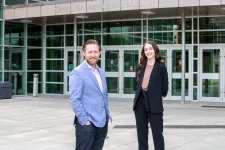(Press-News.org) Arlington, Va., June 29, 2021 - In the midst of the COVID-19 pandemic, infection preventionists at two Southern California hospitals took extreme measures to stop the spread of a deadly fungus that has emerged in the U.S. and around the world. The two will detail their proactive responses in oral presentations today at the Association for Professionals in Infection Control and Epidemiology's (APIC's), 48th Annual Conference.
In separate responses, Scripps Memorial in La Jolla and UCLA Health in Los Angeles isolated suspected or confirmed patients, worked closely with public health departments and information technology and lab teams at their facilities, and implemented aggressive measures to prevent the pathogen, Candida auris, from spreading.
"The fact that these two teams recognized this threat and were able to mobilize so quickly and effectively while also on high alert for COVID is remarkable," said APIC 2021 President Ann Marie Pettis, BSN, RN, CIC, FAPIC. "Their case studies demonstrate how important it is that hospitals, clinics, and long-term care facilities have enough infection preventionists and resources to train staff and monitor safety protocols so they can prevent harm on multiple fronts."
C. auris is a type of fungus that causes severe, often fatal infections and is resistant to most antifungal drugs. It can be carried on a patient's skin and can survive on surfaces for more than a month, allowing it to spread easily among patients. Most hospital disinfectants can't kill C. auris, making it difficult to eradicate from the healthcare environment. It is also easy to misidentify in lab tests.
In March 2020, during the initial influx of COVID-19 patients, infection preventionist Elizabeth A. Jefferson, BS, PhD, CIC, of Scripps Memorial, was notified that her facility had received the first known case of C. auris in San Diego County.
Initially flagged and isolated because the patient had received healthcare abroad, laboratory tests confirmed C. auris in a wound. The patient remained hospitalized in isolation for 47 days, during which time the team implemented aggressive cleaning measures, including use of a disinfectant that was effective against C. auris and UV light for terminal cleaning of all patient rooms.
"Education of staff was essential," said Jefferson. "Staff had to clean and disinfect the room twice a day, and then clean any shared equipment, because if Candida auris sets up shop in your facility, it is extremely difficult to get rid of."
The team partnered with public health, including the CDC's Antibiotic Resistance Lab Network, on routine surveillance testing to ensure there was no transmission.
"Hospitals need to be on the lookout for C. auris," said Jefferson. "You don't know if a patient is colonized or infected unless you have specialized laboratory equipment."
As a result, there was no transmission of the fungal pathogen that has infected nearly 1,800 patients in 15 states and the District of Columbia since it was first detected in the U.S. in 2015.
When C. auris started to surge in Southern California during the summer of 2020, UCLA Health was ready. Knowing the devastation C. auris had caused in other states, they had already created a multi-level notification system designed to catch potential cases early and prevent transmission.
Collaborating with their electronic medical records (EMR) team and the lab, the infection preventionists made sure the EMR system was set up to screen every patient for both COVID and Candida auris when they entered the facility. High-risk patients were flagged and tested appropriately with subsequent notifications sent to infection prevention, environmental services, the lab, and nursing. The system placed holds in patient charts prior to discharge or transfer to enable communication with the health department and receiving facilities about the patient's C. auris status.
The system triggered reminders for stringent cleaning protocols which included testing of environmental surfaces after terminal cleaning to ensure that the patient's room was clear of the organism.
"Having an in-house lab that could test for C. auris and collaborating with the EMR team to build a set of screening steps into our EMR created a failsafe way to ensure we could monitor and track any suspected C. auris cases at our facility. This process was effective in prevention of cross contamination in the healthcare environment" said Urvashi Parti, MPH, infection preventionist at UCLA Health.
Another factor for success was engaging senior leadership so they understood the importance of monitoring both C. auris and COVID at the same time.
"We had the full support of senior leaders who made sure we had the resources to support early identification of C. auris during the COVID-19 pandemic," said Shaunte Walton, MS, CIC, Health System Director of Clinical Epidemiology & Infection Prevention at UCLA Health.
INFORMATION:
About APIC
APIC's Annual Conference, June 28-30, is one of the most comprehensive infection prevention conferences in the world, with more than 100 educational sessions led by experts from across the globe and attended physicians, researchers, epidemiologists, educators, administrators, and medical technologists with strategies that can be implemented immediately to improve prevention programs and make healthcare safer. Join the conversation on social media with the hashtag #APIC2021.
The Association for Professionals in Infection Control and Epidemiology (APIC) is creating a safer world through the prevention of infection. APIC's nearly 16,000 members develop and direct infection prevention and control programs that save lives and improve the bottom line for healthcare facilities. APIC advances its mission through patient safety, education, implementation science, competencies and certification, advocacy, and data standardization. Visit us at apic.org.
The devastating 2012 - 2016 drought in California triggered widespread tree cover loss and die-offs of a variety of species in the region. A new study in the open access journal Frontiers in Climate is the first to show that California's iconic blue oak (Quercus douglasii) woodlands have also decreased by more than 1,200 km2. By another metric, which reflects the altered or deteriorating condition of the tree cover, the blue oak range has lost over 600 km2 in addition. These findings highlight the need to raise awareness about the vulnerability of these ecosystems and to adapt conservation strategies to increasing climate extremes.
"Our ...
Black men most likely to benefit from advanced prostate cancer therapies are 11 percent less likely to get them than non-Black men. This happens despite apparent equal opportunities in obtaining health care services, a new study in American veterans shows.
Publishing in the journal Cancer online June 29, the study showed that Black male veterans were slightly (5 percent) more likely to receive radiation or surgery for prostate cancer than non-Black men and that veterans of all races likely to benefit from such definitive therapy were also 40 percent more likely to get it compared to those who did not need it.
Led by researchers from NYU Langone Health and Perlmutter Cancer Center, the new analysis showed ...
A new paper in JNCI Cancer Spectrum, published by Oxford University Press, indicates that many survivors of adolescent and young adult cancers hesitate to obtain COVID-19 vaccinations.
As of March 2021, there were over 33 million cases and 580,000 deaths from COVID in the United States. Vaccines offer the best hope to control the spread of COVID-19. Some 20%-40% of the US population, however, is hesitant to obtain COVID-19 vaccination. Cancer survivors often have weakened immune systems and are more likely to develop severe respiratory infections, making them particularly vulnerable to the threat of COVID-19.
National organizations recommend strongly ...
According to the World Health Organization, about 785 million people around the world lack a clean source of drinking water. Despite the vast amount of water on Earth, most of it is seawater and freshwater accounts for only about 2.5% of the total. One of the ways to provide clean drinking water is to desalinate seawater. The Korea Institute of Civil Engineering and Building Technology (KICT) has announced the development of a stable performance electrospun nanofiber membrane to turn seawater into drinking water by membrane distillation process.
Membrane wetting is the most challenging ...
CORVALLIS, Ore. - Research by a graduate student in Oregon State University's College of Science has upended the conventional wisdom that for a century has incorrectly guided the study of a toad listed as endangered in part of its range.
Anne Devan-Song used spotlighting - shining a light in a dark spot and looking for eye reflections - to find large numbers of the eastern spadefoot toad. The study illustrates how confirmation bias - a tendency to interpret new information as ratification of existing theories - can hamper discovery and the development of better ones.
Her findings, which show that the toad spends much more time above ground than commonly believed, were published in the Journal ...
Chestnut Hill, Mass. (6/29/2021) -- A new, first-of-its-kind study led by researchers from Boston College has found that personal networks in India could play an important role in advancing the adoption of a cleaner cooking fuel, in this case liquefied petroleum gas, according to a report published in the journal Environmental Research Letters.
"This is the first report in clean cooking research to show that just like with tobacco use, obesity, or physical activity -- where our networks play a role in shaping our behaviors and decisions -- we find that personal networks are also associated with what kinds of stoves rural poor use.," said study co-author ...
The tiny mouse embryo has a heart that beats. Its muscles, blood vessels, gut and nervous system are beginning to develop. But this embryo is unusual: It was made in a lab, out of mouse embryonic stem cells, and represents the most sophisticated in vitro (in a dish) model of a mammal ever so created.
This new model, developed at the University of Virginia School of Medicine by Christine and Bernard Thisse, is a major step forward in scientists' efforts to mimic the natural development of a mammal by using stem cells. Its existence is a wonder that will help scientists understand mammalian development, battle diseases, create new drugs and, eventually, grow tissues and organs for people in need of transplants.
"We found a way to instruct aggregates of stem cells to initiate ...
Immunologists at McMaster University have discovered a previously unknown mechanism which acts like a spider web, trapping and killing pathogens such as influenza or SARS-CoV-2, the virus responsible for COVID-19.
The researchers have found that neutrophils, the most abundant white blood cells in the human body, explode when they bind to such pathogens coated in antibodies and release DNA outside of the cell, creating a sticky tangle which acts as a trap.
The findings, published online in the Proceedings of the National Academy of Science, are significant because little is understood about how antibodies neutralize viruses in the respiratory tract.
The discovery has ...
One of the key mutations seen in the 'Alpha variant' of SARS-CoV-2 - the deletion of two amino acids, H69/V70 - enables the virus to overcome chinks in its armour as it evolves, say an international team of scientists.
SARS-CoV-2 is a coronavirus, so named because spike proteins on its surface give it the appearance of a crown ('corona'). The spike proteins bind to ACE2, a protein receptor found on the surface of cells in our body. Both the spike protein and ACE2 are then cleaved, allowing genetic material from the virus to enter the host cell. The virus manipulates the host cell's machinery to allow the virus to replicate and spread.
As SARS-CoV-2 ...
A conclusive narrative review has found physical punishment of children is not effective in preventing child behavior problems or promoting positive outcomes and instead predicts increases in behavior problems and other poor outcomes over time. The study by an international group of scientists including a researcher from The University of Texas at Austin was published today in The Lancet.
Caregivers in many parts of the world use physical punishment as a response to children's perceived misbehavior: 63% of children between the ages of 2 and 4 worldwide - approximately 250 million children - are regularly subjected ...



